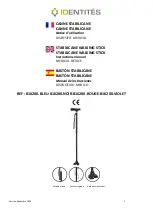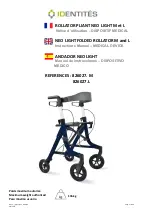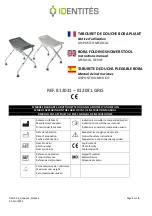
Use
Unfold/fold
• When opening out and when folding the rollator, make sure that no
clothing or parts of the body become trapped. The rollator can be
un-folded by pressing one of the brackets of the back wheels (pic. 3,
point 1). Then push the crossbar down (pic. 3, point 2). The fold lock
(pic. 3, point 3) automatically clicks into place if the cross strut is in the
correct position (pic. 4).
• Check that the fold lock is firmly in position in order to prevent the
rollator from folding together in an unwanted manner. When folding
the rollator remove the shopping basket and the tray first. Press the fold
lock up (pic. 4, point 1) and pull the crossbar up straight (pic. 4, point 2).
Security lever
• The security levers allow the height of the handles to be adjusted individually.
When turn ed anticlockwise they loosen and the handles can be pushed further in or pulled out
(pic. 5, point 1).
• Turn the security levers clockwise and they will tighten (pic. 5, point 2).
• Now adjust the levers so that the ends point downwards by releasing and turning them. This
does not alter the securing effect of the levers!
Brake (pic. 6)
The built-in brake functions as an operating brake for slowing down when moving. The parking
brake can be used when the rollator is stopped.
1.
Speed is reduced by pulling the brake lever upwards (operating brake) (pic 6, point 2).
2.
The parking brake is activated by pressing the brake lever down until it engages (pic 6, point 1).
3.
The parking brake is released from its locked position by pulling the brake lever upwards.
4.
The rollator should not be pushed while the operating or parking brakes have been applied. If the
rollator is pushed while the operating or parking brakes have been applied, the tyres and brakes
may be subject to excessive wear and deteriorate.
5.
Regularly check that the brakes work satisfactorily. We recommend checking before every use. The rollator must not be
used with damaged brakes or damaged wheels.
Brake adjustment (pic. 7)
If the braking force is decreasing due to wear on the wheels, the brake shoe can be adjusted. The brakes must be adjusted
so that both wheels brake evenly. The distance between the brake pad and the wheel surface should be about 2 mm.
After replacing wheels, the brake setting must be checked again and if necessary, readjusted.
1.
Loosen the locking nut.
2.
Adjust the braking force by turning the brake cable spanner inwards or outwards.
3.
Check the braking function by turning the wheels and operating the brake levers. The wheels
should turn freely but stop immediately when the brakes are applied. The wheels must not be
able to move when the brakes are applied.
4.
Tighten the locking nut firmly again.
5.
If you are unsure about the correct adjustment of the brakes, please contact your specialist retailer.
Tray
The tray is designed only for small objects. The little »feet« under the tray enable it to be in serted securely in the holes of
the seat. Do not place hot, heavy or sharp objects on the tray!
Warning: Do not use the tray as a seat!
Shopping basket
The basket allows the user to transport his shopping conveniently. The basket is hung on the hooks
at the right and left below the seat.
Warning:
Only use the basket to transport objects and do not overload it (max. 10 kg)!
pic. 6
1
2
pic. 8
1
2
pic. 3
1
2
pic. 4
pic. 5
1
2
3
pic. 7






































